Caryn
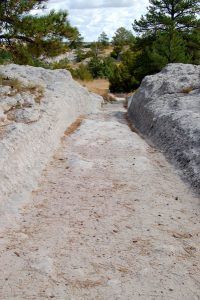 In the years when my kids were in elementary school, every kid in probably 4th or 5th grade got to take a field trip to Guernsey, Wyoming to see the Oregon Trail ruts located there. I don’t know if that is a field trip the schools take anymore, but they did then. Of course, I had seen the Oregon Trail many times before, because my parents loved showing us the history all around us, including stopping at just about every place where the Oregon Trail crossed the highway on our travels. Still, I did not recall seeing the ruts located at Guernsey before, so as a parent who got to go along, it was quite a treat. I was fascinated by the fact that those wagons could make ruts in the rocks. So many of the areas of the Oregon Trail are just a path, or you can’t even tell it’s trail. You just know that it’s where the trail is because of the marker. But there, in the rocks near Guernsey, years after the Oregon Trail was in use, the ruts remain.
In the years when my kids were in elementary school, every kid in probably 4th or 5th grade got to take a field trip to Guernsey, Wyoming to see the Oregon Trail ruts located there. I don’t know if that is a field trip the schools take anymore, but they did then. Of course, I had seen the Oregon Trail many times before, because my parents loved showing us the history all around us, including stopping at just about every place where the Oregon Trail crossed the highway on our travels. Still, I did not recall seeing the ruts located at Guernsey before, so as a parent who got to go along, it was quite a treat. I was fascinated by the fact that those wagons could make ruts in the rocks. So many of the areas of the Oregon Trail are just a path, or you can’t even tell it’s trail. You just know that it’s where the trail is because of the marker. But there, in the rocks near Guernsey, years after the Oregon Trail was in use, the ruts remain.
The Oregon Trail is a 2,170 mile wagon route trail that meandered from the Missouri River to Oregon. It was first laid by fur traders and trappers from about 1811 to 1840. During those years, it was only passable on foot or by horseback. Then by 1836, the wagon trains began to head from Independence, Missouri to places in the west. The trail had been cleared to 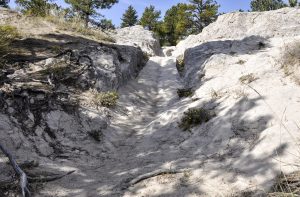 Fort Hall, Idaho by then. As time went on, the trail was cleared all the way to the Willamette Valley in Oregon. These days, the trail crosses our highways in many places, and markers have been placed so the travelers can learn a little history of the trail and what might have happened at each part of it. At the time my parents were showing us all those markers, my sisters and I usually groaned about stopping yet again, at another of the endless Oregon Trail markers that, at that time, we dreaded being forced to read all about. These days, when I think back, I can appreciate the things they tried to show us in this great nation of ours. And I can appreciate the ruts in the rocks outside of Guernsey that have endured for 184 years.
Fort Hall, Idaho by then. As time went on, the trail was cleared all the way to the Willamette Valley in Oregon. These days, the trail crosses our highways in many places, and markers have been placed so the travelers can learn a little history of the trail and what might have happened at each part of it. At the time my parents were showing us all those markers, my sisters and I usually groaned about stopping yet again, at another of the endless Oregon Trail markers that, at that time, we dreaded being forced to read all about. These days, when I think back, I can appreciate the things they tried to show us in this great nation of ours. And I can appreciate the ruts in the rocks outside of Guernsey that have endured for 184 years.
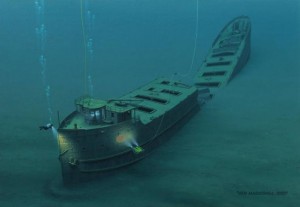 I was listening to a book recently about shipwrecks on the Great Lakes and a thought came to my mind that really made me quite sad…though definitely not as sad as when I consider the loss of life that took place in those many wrecks. My Uncle Bill Spencer told me years ago that the Great Lakes are littered with ships that were lost in some of the worst storms on the lakes. In fact, he told me that if you fly over Lake Superior, which is the lake near where he lived most of his life, you could actually see the ships on the bottom of the lake. That thought always made me want to charter a small plane and go see for myself.
I was listening to a book recently about shipwrecks on the Great Lakes and a thought came to my mind that really made me quite sad…though definitely not as sad as when I consider the loss of life that took place in those many wrecks. My Uncle Bill Spencer told me years ago that the Great Lakes are littered with ships that were lost in some of the worst storms on the lakes. In fact, he told me that if you fly over Lake Superior, which is the lake near where he lived most of his life, you could actually see the ships on the bottom of the lake. That thought always made me want to charter a small plane and go see for myself.
Shipwrecks aside, the book told of the different reasons that ships went down, and how the safety regulations were often extremely inadequate. From not enough lifeboats, to lifejackets that were stored to far from the posts to be reached, to companies who regularly pressured their 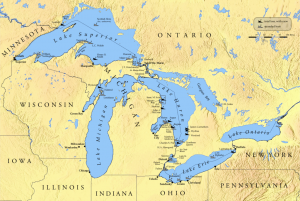 captains to take their ships out in terrible storms, the life of the sea was very dangerous. Of course, there are still shipwrecks today, although the last sinking on the Great Lakes was on November 10, 1975, when the SS Edmond Fitzgerald went down in a horrible November gale. With more recent safety regulations, the Great Lakes have been able to stave off shipwrecks in the last 45 years.
captains to take their ships out in terrible storms, the life of the sea was very dangerous. Of course, there are still shipwrecks today, although the last sinking on the Great Lakes was on November 10, 1975, when the SS Edmond Fitzgerald went down in a horrible November gale. With more recent safety regulations, the Great Lakes have been able to stave off shipwrecks in the last 45 years.
Still, it is not the number of wrecks, or even the lives lost, that has me considering a loss that is even greater…and least from the viewpoint of genealogy. As I was listening to the book, I heard that in several situations, they could not get an exact count of the lost, even if they technically knew how many were on board. The ships manifests had gone down with the ship. My mind raced. If there were people on those ships who had 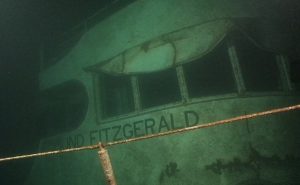 immigrated here, and their names were not recorded somewhere, they could virtually disappear and along with them, their line in the family tree they came from. I know that the many genealogy fanatics, like me, would just cringe at the thought of one of our ancestors simply vanishing. There are so many ways for a family line to get muddied. Name changes, marriages, undocumented deaths, as well as those who just left without telling anyone, are all among the lost ones, but I hadn’t considered those who meant to stay in touch, but who were never heard from, and their family back in Europe or wherever they came from, had no idea what happened. All they knew was that they were lost forever.
immigrated here, and their names were not recorded somewhere, they could virtually disappear and along with them, their line in the family tree they came from. I know that the many genealogy fanatics, like me, would just cringe at the thought of one of our ancestors simply vanishing. There are so many ways for a family line to get muddied. Name changes, marriages, undocumented deaths, as well as those who just left without telling anyone, are all among the lost ones, but I hadn’t considered those who meant to stay in touch, but who were never heard from, and their family back in Europe or wherever they came from, had no idea what happened. All they knew was that they were lost forever.
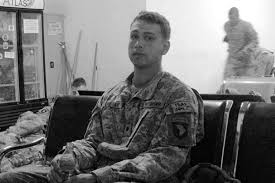 So many of the men and women who return from combat, when many of their buddies didn’t, suffer from a multitude of feelings. Many feel like it should been them killed in the bombing, shooting, plane crash, or whatever it might have been that took their buddy or buddies, and somehow let them alive. No matter that they were quite possibly wounded too, maybe even lost a limb. The point was that somehow they had come back alive, and they carry the guilt of that with them always.
So many of the men and women who return from combat, when many of their buddies didn’t, suffer from a multitude of feelings. Many feel like it should been them killed in the bombing, shooting, plane crash, or whatever it might have been that took their buddy or buddies, and somehow let them alive. No matter that they were quite possibly wounded too, maybe even lost a limb. The point was that somehow they had come back alive, and they carry the guilt of that with them always.
Some of those returning heroes struggle with the loss of their feeling all their lives. Some of them take risks, feeling like they are living on borrowed time, and if their time comes, it will almost be a form of justice. Some feel 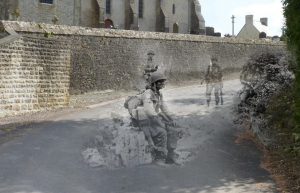 like it is borrowed time, but look at it more like living a gift. They might try to live up to what they think would make their buddies would be proud of. It doesn’t matter how they live their lives, for some, it will never be enough…in their minds anyway. They feel like their buddy died, and because of that, they can have a family…one their buddy never got to have. And if those buddies who were lost had a family, they feel an even greater burden, because not only did their buddy lose out of being with his family, but the family lost him too.
like it is borrowed time, but look at it more like living a gift. They might try to live up to what they think would make their buddies would be proud of. It doesn’t matter how they live their lives, for some, it will never be enough…in their minds anyway. They feel like their buddy died, and because of that, they can have a family…one their buddy never got to have. And if those buddies who were lost had a family, they feel an even greater burden, because not only did their buddy lose out of being with his family, but the family lost him too.
War is not an easy thing to go through, and those of us who are home, especially those of us with no one in the war, cannot really understand what  they go through either in the war, or after the war. It’s impossible. There are other kinds of survivors guilt, and I don’t suppose one is easier than the other, but it seems to me that because of the trust, companionship, and love these men feel for each other; and the idea that in the end, he couldn’t save the buddy or buddies who he felt were somehow his responsibility…well, it would be devastating. I can’t even begin to imagine. And the mind is a tough thing to get past, once it gets an idea firmly ingrained in it. For many soldiers, finally deciding that they aren’t living on borrowed time is a lifelong process, and all their family can do is pray they can make the transition back to living life again. I pray they can too.
they go through either in the war, or after the war. It’s impossible. There are other kinds of survivors guilt, and I don’t suppose one is easier than the other, but it seems to me that because of the trust, companionship, and love these men feel for each other; and the idea that in the end, he couldn’t save the buddy or buddies who he felt were somehow his responsibility…well, it would be devastating. I can’t even begin to imagine. And the mind is a tough thing to get past, once it gets an idea firmly ingrained in it. For many soldiers, finally deciding that they aren’t living on borrowed time is a lifelong process, and all their family can do is pray they can make the transition back to living life again. I pray they can too.
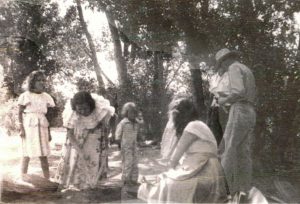 My grandfather, George Byer was always a rock hunter. In hard times, when trips were not possible, he shared his love of rocks with his family. You didn’t have to go far to look for rocks…you didn’t even have to leave home. Still, when you raise a family of rock lovers, the back yard gets picked over pretty quickly. Nevertheless, there was always someplace that he could take his family for a picnic and rock hunting excursion, and every one of the kids became rock lovers too, as did many of his grandchildren, great grandchildren, and the list has continued long after his passing.
My grandfather, George Byer was always a rock hunter. In hard times, when trips were not possible, he shared his love of rocks with his family. You didn’t have to go far to look for rocks…you didn’t even have to leave home. Still, when you raise a family of rock lovers, the back yard gets picked over pretty quickly. Nevertheless, there was always someplace that he could take his family for a picnic and rock hunting excursion, and every one of the kids became rock lovers too, as did many of his grandchildren, great grandchildren, and the list has continued long after his passing.
If you aren’t a rock lover, you could so easily miss the beauty that is found in many of the stones around us. On the outside, they may look like they are just a plain black, brown, or white stone, but when it is cut or broken open, you find a stunningly colorful stone inside, even a gem in some cases. Of course, these days, we have to be careful where we do our rock hunting, because there are rock hunters who have staked and registered their claim on certain areas. But as long as you steer clear of those areas, rock hunting is a free way to get out and find nature’s best treasures.
Grandpa Byer loved his rocks so much that he later bought a rock polisher, and made beautiful jewelry and key chains from the rocks he found. I think many of his grandchildren have been blessed to receive such a gift as a memento of the treasure that was our grandpa. These pieces are precious to us. Somehow, they are filled with all the stories our parents have told us about the joys of rock hunting with their family. I think most of them loved rock hunting all their lives. I’ll never forget my mom telling me about their rock hunting trips, sometimes 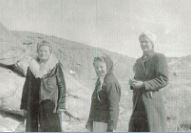 to Independence Rock, sometimes by the river, and sometimes the kids went by themselves. Wherever they went, they always came back with the treasured rocks.
to Independence Rock, sometimes by the river, and sometimes the kids went by themselves. Wherever they went, they always came back with the treasured rocks.
The rock stories remained even after my grandparents were in Heaven. Of course they did. My aunts and uncles were so blessed to carry those memories in their hearts for their entire lives, and we were blessed that they could pass them along to their own children and grandchildren. I don’t think I ever grew tired of hearing about their trips to find rocks. My mom used to tell me all about how much fun the had. These are the kind of memories that stay with you long after the people in them are gone.
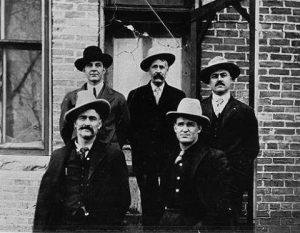 In the early years of Wyoming’s history, there was contention between cattle ranchers and sheep ranchers. The cattlemen thought the land was theirs, and they thought the sheepmen were invading their domain, and they weren’t going to allow it. Cattlemen were first to arrive in the Big Horn Basin, trailing in huge herds of cattle in 1879. They insisted their early arrival established a prior claim to the grass on the government land where their herds grazed. But the law said otherwise. The Cattle and Sheep Wars sprung from this dispute in the Western United States, but they were most common in Texas, Arizona, and the border region of Wyoming and Colorado. The cattlemen thought the sheep destroyed the public grazing lands, which they had to share on a first-come, first-served basis.
In the early years of Wyoming’s history, there was contention between cattle ranchers and sheep ranchers. The cattlemen thought the land was theirs, and they thought the sheepmen were invading their domain, and they weren’t going to allow it. Cattlemen were first to arrive in the Big Horn Basin, trailing in huge herds of cattle in 1879. They insisted their early arrival established a prior claim to the grass on the government land where their herds grazed. But the law said otherwise. The Cattle and Sheep Wars sprung from this dispute in the Western United States, but they were most common in Texas, Arizona, and the border region of Wyoming and Colorado. The cattlemen thought the sheep destroyed the public grazing lands, which they had to share on a first-come, first-served basis.
On April 2, 1909, the range war between the cattlemen and sheepmen in the Ten Sleep, Wyoming area came to a head, when a group of cattlemen decided that they were going to settle this battle once and for all. They headed to Spring Creek seven miles south of Ten Sleep, Wyoming where they knew of a camp. This was to be the last of the sheep raids in the Big Horn Basin. That fateful day, seven cattlemen attacked a sheep camp near 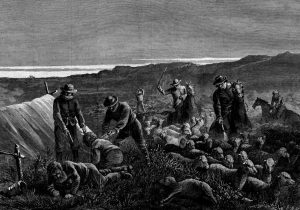 Spring Creek, just south of Ten Sleep, in the southern Big Horn Basin. When the raiders attacked, they killed three men, two of whom the burned to death in their sheep wagon. Then shooting the third man, the decided to kidnap two others. Then they killed the sheep dogs and dozens of sheep and destroyed thousands of dollars of personal property. It was the deadliest sheep raid in Wyoming history. I understand killing in war, but this was murder, and it was horrific!!
Spring Creek, just south of Ten Sleep, in the southern Big Horn Basin. When the raiders attacked, they killed three men, two of whom the burned to death in their sheep wagon. Then shooting the third man, the decided to kidnap two others. Then they killed the sheep dogs and dozens of sheep and destroyed thousands of dollars of personal property. It was the deadliest sheep raid in Wyoming history. I understand killing in war, but this was murder, and it was horrific!!
Wyoming was a territory from July 25, 1868 to July 10, 1890. Early on, there were more cattle ranches than sheep ranches, and the cattlemen felt like they had priority to public lands. Sheep raids began to plague Wyoming since the late 1890s, by which time sheep outnumbered cattle on Wyoming ranges. By 1909, at least six men had been killed, thousands of sheep had been slaughtered, and many thousands of dollars of property destroyed. Nevertheless, there had not been a single conviction for a crime committed during a sheep raid.
It’s really no surprise, given the rising numbers of sheep on the range in those years, that cattlemen were 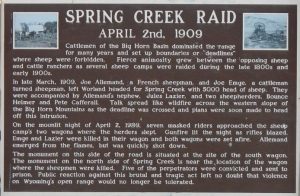 feeling pressured. By 1894 there were 1.7 million sheep in Wyoming and only 675,000 cattle. By 1909, the state’s peak year for sheep, there were more than six million sheep, and only 675,000 cattle. It makes sense that there were tensions, but that did not excuse the men on either side committing murder. Yes, Wyoming was a part of the wild west, and the lawmen were not always readily available, but that did not mean that these men should be able to kill the competition. We are ultimately, civilized people after all, even if we do live in the wild west. After the arrests for the Spring Creek Raid, the cattlemen we reluctant to raid the sheep camps, and with that, a horrific event of the old west passed into history.
feeling pressured. By 1894 there were 1.7 million sheep in Wyoming and only 675,000 cattle. By 1909, the state’s peak year for sheep, there were more than six million sheep, and only 675,000 cattle. It makes sense that there were tensions, but that did not excuse the men on either side committing murder. Yes, Wyoming was a part of the wild west, and the lawmen were not always readily available, but that did not mean that these men should be able to kill the competition. We are ultimately, civilized people after all, even if we do live in the wild west. After the arrests for the Spring Creek Raid, the cattlemen we reluctant to raid the sheep camps, and with that, a horrific event of the old west passed into history.
 April Fools’ Day has long been a day to play practical jokes on friends and family, and most of us have taken part in the practice each year. The key to April Fools’ Day is when you get to see the look on your “victim’s” face. This year, it seems that a virus had the best joke…for lack of a better phrase for it, because there is nothing funny about COVID19. The virus has wreaked havoc on the world. And now it’s April Fools’ Day, and most of the United States citizens have been told to distance themselves from each other. On April Fool’s Day, that is a cruel joke.
April Fools’ Day has long been a day to play practical jokes on friends and family, and most of us have taken part in the practice each year. The key to April Fools’ Day is when you get to see the look on your “victim’s” face. This year, it seems that a virus had the best joke…for lack of a better phrase for it, because there is nothing funny about COVID19. The virus has wreaked havoc on the world. And now it’s April Fools’ Day, and most of the United States citizens have been told to distance themselves from each other. On April Fool’s Day, that is a cruel joke.
April Fools’ Day pranks don’t really work well by phone, email, or text, although I suppose that, to a degree, Skype or Facetime would allow the prankster to see the 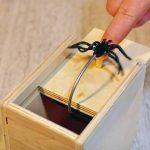 face of their victim. Still, part of the fun is more than just their face. A perfect April Fools’ Day joke produces more than just a shocked face, the body language is a part of it too. My family loved April Fools’ Day pranks, and while the jokes varied, going from the typical childlike jokes, like trying to convince our sisters that they had a spider on them, when they were old enough to know that it was an April Fool’s Day joke. If they were feeling generous, they might pretend to be scared, but that reaction was usually reserved for the youngest sister at the time. The rest of us had to step up our game. Somehow, I just can’t imagine any of
face of their victim. Still, part of the fun is more than just their face. A perfect April Fools’ Day joke produces more than just a shocked face, the body language is a part of it too. My family loved April Fools’ Day pranks, and while the jokes varied, going from the typical childlike jokes, like trying to convince our sisters that they had a spider on them, when they were old enough to know that it was an April Fool’s Day joke. If they were feeling generous, they might pretend to be scared, but that reaction was usually reserved for the youngest sister at the time. The rest of us had to step up our game. Somehow, I just can’t imagine any of  those jokes working very well by text. I wouldn’t even know how to set it up from that distance.
those jokes working very well by text. I wouldn’t even know how to set it up from that distance.
This year, with “social distancing” as a new part of our reality, the joke appears to be on the pranksters. Oh I might be able to prank my husband…and I probably will, because let’s face it, he’s here, and I am a prankster…and he is pretty much the only “victim” available. Yes, April Fools’ Day pranks will be much different this year, but in light of the fact that we all have cabin-fever, maybe some creative pranking is just the think we all need. So…prank it up all you dedicated April Fools’ Day pranksters. We must never give up without a fight!!


 My niece, Liz Masterson is a teacher of Journalism and English at Kelly Walsh High School in Casper, Wyoming. She is a dedicated teacher, who loves her job and her students, and they love her too. She isn’t an easy teacher, but the students learn from her, and they work hard for her, because she draws the best out of them.
My niece, Liz Masterson is a teacher of Journalism and English at Kelly Walsh High School in Casper, Wyoming. She is a dedicated teacher, who loves her job and her students, and they love her too. She isn’t an easy teacher, but the students learn from her, and they work hard for her, because she draws the best out of them.
This school year began normally, but as we all know, it has progressed in an anything but normal manner. Due to the COVID19 Pandemic, the schools have been closed since March 13th. Spring Break was supposed to have started on March 30th, but of course, it has been closed for two weeks already. In reality, the teachers and administration are working very hard, albeit at home, to prepare to finish this seriously unconventional school year. Since moving into the new part of Kelly Walsh, Liz’s students have been using Google Classroom for parts of their classes. That is most definitely a good thing, because it is Google Classroom that will be put into action to finish the school year. It will, however, be used differently than they are used to. Still, it is a form of remote learning, and it will allow the students and teachers to finish the school year. It has to be done, because you can’t just pass a generation of students with three months less class time than they should have.
For Liz, this unique situation is like being on hold or in limbo. Teachers are used to having their summer off, so two and a half months of no school feels normal, but summer is planned for…prepared for. This is nothing like that. She feels at loose ends. She misses her students and the classroom discussions they had. She misses the co-workers she had. She misses the sports, which she took pictures of for the annual, mostly because she is the biggest sports fan ever!! I think they were happy to have Liz take pictures of the sports, because she caught the essence of the plays. That’s because she saw the game from the mind of the players.
There are so many regrets that come with an unfinished school year, especially for the Seniors. This is their last year. so many things that they will never be able to do again…prom, graduation, the last part of being the top class. In sports, they miss the scouts, and possible chances at sports scholarships. For teachers, there are regrets too. Teachers are destined to teach, and to suddenly not be able to be stand before the class and see their faces as they get what is being taught, to see their smiling faces…it defeats the whole concept of 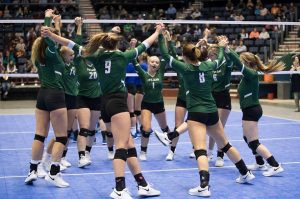
 classroom teaching. This generation of students and their teachers can never get back the last three months of the 2020 school year, and that is a loss indeed. Nevertheless, today is Liz’s birthday, and I know that her students wish her the best, as do we, her family. And while this is a strange school year, I hope it will still be rewarding. Happy birthday Liz!! Have a great day!! We love you!!
classroom teaching. This generation of students and their teachers can never get back the last three months of the 2020 school year, and that is a loss indeed. Nevertheless, today is Liz’s birthday, and I know that her students wish her the best, as do we, her family. And while this is a strange school year, I hope it will still be rewarding. Happy birthday Liz!! Have a great day!! We love you!!
 Not many people these days have heard of Hedy Lamarr, but I have heard of her, because she was an actress in my parents’ era. It goes without saying that Hedy Lamarr was beautiful…by any standard. Hedy Lamarr was a star in the 1930s and 1940s, starring in some well known movies including Boom Town with Clark Gable and Samson and Delilah with Victor Mature. While she’s certainly famous because of her acting career, she didn’t make any big world changes because she starred in some old movies. Instead, Hedy Lamarr had a pastime that did change the world. You wouldn’t know it…or certainly you wouldn’t expect it…but in her spare time Hedy Lamarr liked to work on her inventions. Seriously, who would have thought that?
Not many people these days have heard of Hedy Lamarr, but I have heard of her, because she was an actress in my parents’ era. It goes without saying that Hedy Lamarr was beautiful…by any standard. Hedy Lamarr was a star in the 1930s and 1940s, starring in some well known movies including Boom Town with Clark Gable and Samson and Delilah with Victor Mature. While she’s certainly famous because of her acting career, she didn’t make any big world changes because she starred in some old movies. Instead, Hedy Lamarr had a pastime that did change the world. You wouldn’t know it…or certainly you wouldn’t expect it…but in her spare time Hedy Lamarr liked to work on her inventions. Seriously, who would have thought that?
World War II began in 1939, but after the Japanese attacked Pearl Harbor on December 7, 1941, the United States entered the war. By 1942, Lamarr was at the height of her acting career. Still, like many patriotic Americans, she wanted to help in the war effort. She could have gone in as a nurse, or something, but she had something else in mind. Hedy Lamarr wanted to help the Allies come up with a communications system that couldn’t be intercepted by enemies. Now, I can only imagine how that would have gone over in an era where woman were thought not to understand the ways of war. So she and her friend, composer George Antheil, patented an idea for something they called the “Secret Communications System.” It was a system that would change radio frequencies in a per-programmed method. I hadn’t heard of such a method, although I suppose others have. If someone was listening…and the enemy was always trying to listen, they would only hear snippets before it changed to a different frequency. It sounds logical, but ultimately, the military didn’t end up using the system.
Flash forward a few decades, and you will find that Lamarr and Antheil’s patent became really important because it was a cheap and effective way to create security in new emerging technologies like military communication, cellular phones, and WiFi. What the military couldn’t use effectively in World War II, became important part of modern-day communication, and something most of us couldn’t do without…especially in the an 
![]() middle of a global pandemic. To look at her, Hedy Lamarr would have instantly been classified as a pretty girl, but most likely with out a head for mathematics or science…especially not in the field of electronics, but that classification would have proved very wrong. Hedy Lamarr had it all…looks and brains. Her contributions to modern-day technology prove that. As for Lamarr, her film career cooled down in the 1950s and her last movie was released in 1958. She became reclusive in her later life and passed away on January 19, 2000. She was 86.
middle of a global pandemic. To look at her, Hedy Lamarr would have instantly been classified as a pretty girl, but most likely with out a head for mathematics or science…especially not in the field of electronics, but that classification would have proved very wrong. Hedy Lamarr had it all…looks and brains. Her contributions to modern-day technology prove that. As for Lamarr, her film career cooled down in the 1950s and her last movie was released in 1958. She became reclusive in her later life and passed away on January 19, 2000. She was 86.
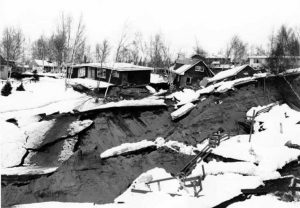
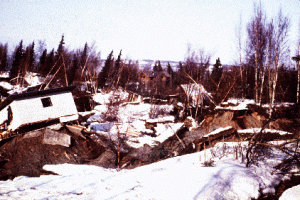 The earthquake struck at 5:35pm local time on Good Friday, March 27, 1964. Its epicenter was 12.4 miles north of Prince William Sound, 78 miles east of Anchorage and 40 miles west of Valdez. Across southcentral Alaska, ground fissures, collapsing structures, and tsunamis resulting from the earthquake caused about 131 deaths. Soil liquefaction, fissures, landslides, and other ground failures caused major structural damage in several communities and much damage to property. Anchorage was hit very hard, and sustained great destruction or damage to many inadequately earthquake-engineered houses, buildings, paved streets, sidewalks, water and sewer mains, electrical systems, and other man-made equipment, particularly in the several landslide zones along Knik Arm. Two hundred miles southwest, some areas near Kodiak were permanently raised by 30 feet. Southeast of Anchorage, areas around the head of Turnagain Arm near Girdwood and Portage dropped as much as 8 feet, requiring reconstruction and fill to raise the Seward Highway above the new high tide mark.
The earthquake struck at 5:35pm local time on Good Friday, March 27, 1964. Its epicenter was 12.4 miles north of Prince William Sound, 78 miles east of Anchorage and 40 miles west of Valdez. Across southcentral Alaska, ground fissures, collapsing structures, and tsunamis resulting from the earthquake caused about 131 deaths. Soil liquefaction, fissures, landslides, and other ground failures caused major structural damage in several communities and much damage to property. Anchorage was hit very hard, and sustained great destruction or damage to many inadequately earthquake-engineered houses, buildings, paved streets, sidewalks, water and sewer mains, electrical systems, and other man-made equipment, particularly in the several landslide zones along Knik Arm. Two hundred miles southwest, some areas near Kodiak were permanently raised by 30 feet. Southeast of Anchorage, areas around the head of Turnagain Arm near Girdwood and Portage dropped as much as 8 feet, requiring reconstruction and fill to raise the Seward Highway above the new high tide mark.
I came to know of this horrific 9.2 magnitude earthquake when my husband, Bob and I were on a cruise to Alaska. The cruise ended in Anchorage, and we had taken an extra day for exploration of the area. My first notice of this Alaskan earthquake was on a shuttle ride from the airport to Anchorage proper. We had the day before our flight at 10:30pm, so we stored our luggage at the airport and took the shuttle back into town. The shuttle driver took us by the Turnagain Heights neighborhood, the current location of Earthquake Park. She told us that the soil there had liquified and homes were swallowed…some almost completely, leaving only their chimneys above ground, while others were swept out to sea in the ensuing tsunami waves. I couldn’t shake the dreadful feeling of the horror that had happened there. A stop in a museum, including a documentary about the 1964 Alaskan earthquake, told me that the earthquake that happened in the modern-day Earthquake Park, was the 1964 Alaskan earthquake. Of course, I was only 8 years old when it happened, so I guess that it is not so odd that I hadn’t heard of it.
We began a much longer than expected walk along the Tony Knowles Coastal Bicycle Trail. Of course, people were walking on the trail too, but we had no idea how long the walk back to the airport would be. Nevertheless, the walk took us through Earthquake Park, and…well, I have only noticed such an air of heaviness in one other place…Gettysburg Battlefield. There is something about being in a place where so much death and destruction occurred. I takes on an air of being “hallowed ground” somehow. President Lincoln knew what he was talking about when he gave the Gettysburg Address. Walking through Earthquake Park, you could see the rippled ground, where the liquified soil had rolled back and forth during the earthquake. We didn’t get off the trail, so if there were chimneys visible near us, we didn’t see them, but I was moved to think that beneath our feet, there might be houses that people had lived in. I didn’t know if the people who had lived there were there still, or if 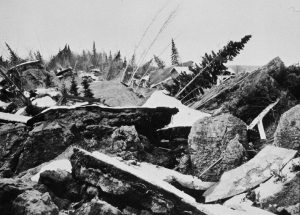
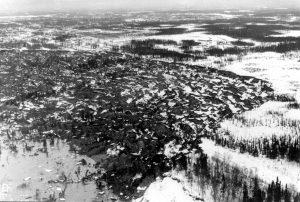 they had been located and buried after the disaster. Whatever the case may be, I left the area feeling very different than I had just two days earlier. I had been in the exact place where such a devastating disaster had happened, and I have never forgotten that place, just as I have never forgotten the feeling I felt at Gettysburg. Some things just have a profound effect on us…forever.
they had been located and buried after the disaster. Whatever the case may be, I left the area feeling very different than I had just two days earlier. I had been in the exact place where such a devastating disaster had happened, and I have never forgotten that place, just as I have never forgotten the feeling I felt at Gettysburg. Some things just have a profound effect on us…forever.
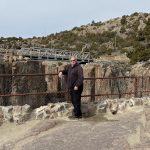
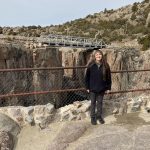 Our world has changed so much over the past few weeks that it is almost unrecognizable to us…not the landscape itself, but rather our view of it, and everything in it. Most of us figured it would be an election, or a recession that would change things for us, but we could never have expected the change a global pandemic could produce. We’ve learned new words, like social distancing; and words we knew that didn’t seem so daunting before, like essential worker and mandatory shelter-in-place orders, suddenly bring an unwanted wave of emotions. Businesses are closed, as are schools, and suddenly we find ourselves spending an inordinate amount of time at home. The kids might like their new free time, but most adults just want things to be back to normal…and very soon!!
Our world has changed so much over the past few weeks that it is almost unrecognizable to us…not the landscape itself, but rather our view of it, and everything in it. Most of us figured it would be an election, or a recession that would change things for us, but we could never have expected the change a global pandemic could produce. We’ve learned new words, like social distancing; and words we knew that didn’t seem so daunting before, like essential worker and mandatory shelter-in-place orders, suddenly bring an unwanted wave of emotions. Businesses are closed, as are schools, and suddenly we find ourselves spending an inordinate amount of time at home. The kids might like their new free time, but most adults just want things to be back to normal…and very soon!!
My husband. Bob and I are both retired, and we are used to spending quite a bit of time together, but lately I have noticed that we might be going a little bit stir crazy. It isn’t that we don’t want to be together, but rather that we are feeling cooped up. As yesterday morning progressed, we seemed to be picking at each other more 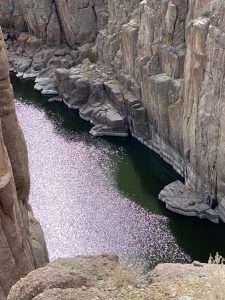
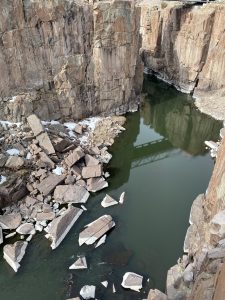 and more. It was then that it hit me. We had to get out of the house for a while. Still, while Wyoming is not under a mandatory shelter-in-place order, we are supposed to be practicing social distancing. I thought about it, and decided that I had a way to get out and obey the social distancing guidelines, because they slow the spread of the disease.
and more. It was then that it hit me. We had to get out of the house for a while. Still, while Wyoming is not under a mandatory shelter-in-place order, we are supposed to be practicing social distancing. I thought about it, and decided that I had a way to get out and obey the social distancing guidelines, because they slow the spread of the disease.
So we jumped in the pickup, and took a drive to Alcova Lake southwest of Casper. We were still social distancing, because we were in the pickup, but part way to the lake, we both breathed a sigh of relief. Suddenly we felt free from all of the stresses of COVID-19 and the locked down feeling it brought with it. The world around us seemed normal. A drive through the countryside showed us that the Earth really took no notice of the “Viral War” raging around it. Earth’s beauty, though currently still mostly hidden under Winter’s brown and white coat, was just beginning to show the green blades of Spring grass peeking out toward the sun. We stopped at a picnic area at Fremont Canyon bridge and got out to have a look. There was no one there, but us. The wind was calm, and the place was so peaceful. We walked to the viewing site, and looked at the rocks 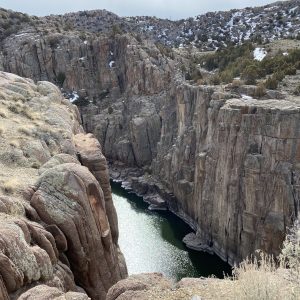
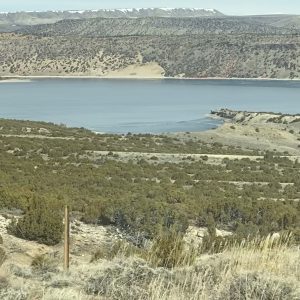 below, the white high water lines visible in Winter’s low water season. The sun sparkled on the water of the river. We stood and looked at the peaceful sight, feeling renewed…feeling one with each other again. Then, all too soon, we got back in the pickup for the drive home, and the workout we had delayed, because while exercise is very important, this was important too. We needed this, and we will do it again. We hope that no mandatory shelter-in-place order comes, because a drive would not be possible then, but we are very thankful to have had this drive, and the renewal it brought to us.
below, the white high water lines visible in Winter’s low water season. The sun sparkled on the water of the river. We stood and looked at the peaceful sight, feeling renewed…feeling one with each other again. Then, all too soon, we got back in the pickup for the drive home, and the workout we had delayed, because while exercise is very important, this was important too. We needed this, and we will do it again. We hope that no mandatory shelter-in-place order comes, because a drive would not be possible then, but we are very thankful to have had this drive, and the renewal it brought to us.

